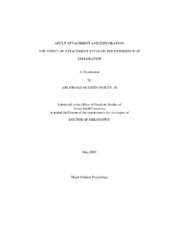| dc.description.abstract | According to attachment theory a key moderator in the enjoyment of exploration
is the strength of a person's secure base. To study exploration we placed participants in a
situation in which they confronted a novel stimulus. We also gathered self-reported data
on their mood immediately before and after this encounter with a novel stimulus as well
as their attitudes about the novel stimulus activity. The effect of a ?secure base? on this
encounter was examined in two ways: first through chronic attachment, and second
through priming participants with either a secure attachment prime, an insecure
attachment prime or a neutral prime. Thus, this study makes two categories of
predictions: the first regarding the effect of chronic attachment, and the second regarding
the effect of primed attachment. Regarding the effect of chronic attachment, we
predicted that there would be an interaction between the novelty of the stimulus and
chronic attachment. Specifically, we found that both chronic attachment avoidance and
chronic attachment anxiety predicted greater tense mood following the activity and
greater anxiety about the activity. In addition, we found that chronic avoidant attachment was related to greater anger following the activity and less happiness following the
activity. These results remained significant even when mood immediately before the
activity was controlled.
Regarding primed attachment, we found that there was an interaction between
primed attachment and novelty condition. (During the study, participants in the low
novelty condition interacted more extensively with the novelty stimulus than did
participants in the high novelty condition.) Specifically, we found that participants in the
low novelty condition reacted more strongly to the attachment prime than participants in
the high novelty condition. Further, the attachment prime predicted the direction of the
change in mood. Thus, for the low novelty conditions, participants primed with secure
attachment reported significantly more happiness and higher positive affect on a
composite mood scale, compared with participants primed with insecure attachment. In
the same way, again for the low novelty conditions, participants primed with secure
attachment reported significantly lower levels of anger, compared with participants
primed with insecure attachment. | en |


